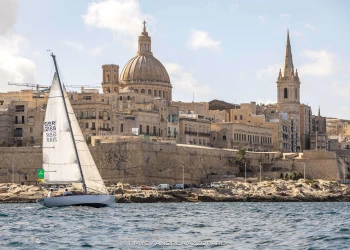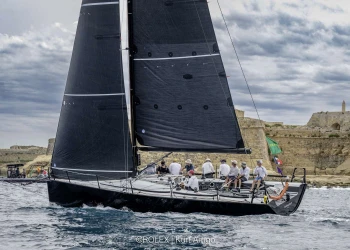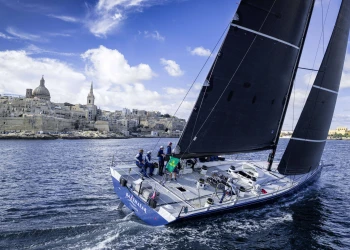
2024 Rolex Middle Sea Race : Fast Exit
The 45th Rolex Middle Sea Race fleet was let loose from Grand Harbour, Valetta, this morning, with crews experiencing lively conditions as they exited the historic port. In contrast to recent years, the breeze was up and held throughout 90 minutes of start proceedings.
Gusts were fully evident from on high, squirrelling across the magnificent harbour as the south easterly gradient wind served up a spring board to launch the boats. The geography and architecture of the enclosed harbour played a full part as yachts encountered both lulls and stronger than expected puffs. The full complement of 112 entrants embarked on the 606 nautical mile race, and by early evening were well on their way to Capo Passero, on the southeastern tip of Sicily.
As so often is the case with the Rolex Middle Sea Race, talk on the dock was of the uncertainty of the conditions over the race course. The weather has been in a teasing mode all week as a low pressure system has circulated the Maltese archipelago. On the plus side, there was no rain likely for the start. On the down side, the anticipated fast reach north was unlikely to materialize. At 16:00 CEST the fleet was midway between Malta and Sicily making the best of an unstable north westerly and the threat of thunder storm activity. Leading on the water, Black Jack 100 had fought her way past the Class40 Marvic 40 of Aurélien Ducroz, which started a full hour ahead and whose Lombard design had doggedly held off the Maxi division for longer than anticipated. Tactical questions are already being posed, with one group including Remon Vos’ Black Jack and Seng Huang Lee’s Scallywag 100, some way to the east of the rhumb line. Marvic 40 is the most westerly, with Bryon Ehrhardt’s Lucky from the United States the most easterly. Another group of mainly smaller entrants is north of the direct course. Slovenian entry Maks Vrečko’s Elan 450 Karpo is closest, with Stefan Debattista & Sam O’Byrne’s IMX 40 Geisha from Malta the outsider. In between the fleet spreads wide and deep, with the Stefan Jentzsch skippered German Botin 56 Black Pearl holding the centre ground.
Start 1
Each start had a flavour of its own. First away were the six Class40s, and the lone multihull, Aldo Fumagalli’s Rapido 53XS, Picamole. Among Fumagalli’s crew is Patrick Phelipon, who first did the race back in 1972. Andrea Fornaro’s Influence 2 and Matteo Serricano’s Lucente made timed runs to split the line perfectly, and as the cannon smoke cleared Influence 2 at the Saluting Battery was in a clear lead. Lucente was struggling to set her spinnaker, and was almost overtaken by the older Talanta skippered by Austrian Michael Pühse. By the inner breakwater, Influence and Lucente were neck and neck, the remaining four some way behind. By the Dragonara turning mark, just under two miles from the mouth of Grand Harbour, Influence had stretched into a lead, before stalling and sadly retiring half a mile later with rudder problems. Lucente stood on at the mark to head further northwest before gybing to the northeast. Marvic40 turned hard right, and this decision appears to have worked in her favour.
Start 2
Next to go were the smallest and least powerful yachts in the fleet. Featuring 22 yachts, including six Maltese boats. Winning the start by some margin was the Croatian Sun Fast 3300 Munjek skippered by Dusko Tomić. Massimo Licata D'Andrea’s Italian First 35 South Kensington was in hot pursuit. Two Maltese boats also made fantastic starts, both featuring young local sailors. The J/109 JYS Jan skippered by Claudio Bugeja and the Sun Odyssey 45 Janissah of Royal Malta Yacht Club (RMYC) Rear Commodore Mario Debono. Looking at the tracker, South Kensington sailing close to the rhumb line to Capo Passero ranked as class leader in IRC 6 and second overall. Second in class was the oldest boat in the race, the 1974 Auzepy-Brenneur designed mahogany ketch, El Oro from Australia and skippered by Kent King. Paul Sheahan’s Irish X-37 Chillax on its first ever Rolex Middle Sea Race was holding onto third.
Start 3
The third start featured 17 teams, many of which are racing double-handed. A pack of fully-crewed boats got away well near the middle of the line. None more so than Seb Ripard and Dan Calascione’s Maltese Farr 30 Calypso. Kazakhstan’s Peter Lezhnin racing the J/112 Jedi was not far behind, as was Geisha. At the pin end, Manuel Costantin’s Italian Oceanis 46 Jules got a superb start and led the fleet down Grand Harbour. The Maltese J/112 OpenPayd BeFree co-skippered by Horst Huesley and Jonathan Camilleri Bowman was also in the leading pack as the group headed out into open water. At the time of writing, Karpo was not only top of the IRC 5 class leader board, but also leading the race overall. The extended Karpo Family in Malta will be loud and proud about that, enjoying the fame for as long as it lasts. Second in class and third overall was former Rolex Fastnet Race winner, Didier Gaudoux and his MN35 Lann Ael 3 from France, the most easterly boat in the class and racing with just two on board. Geisha, the most westerly boat in class, is hanging on to third.
Start 4
The fourth start featured a myriad of yacht designs from the classic Australian Swan 65 ketch Eve, entered by Steve Capell and Fraser Welch, to new designs such as Margus Uudam’s Estonian MAT 1220 Nola. With 21 boats on the start and a pulsating wind gusting well over 20 knots, the adrenalin was pumping in the dial-up. First 45 Elusive 2 sailed by Aaron, Christoph and Maya Podesta, fully nailed the gun. On the B of the bang, Elusive hoisted their blue kite in the middle of the line and headed straight for the gap in the breakwater. On Elusive’s hip to windward was Andrew and Sam Hall’s British J/125 Jackknife and to leeward was Jonathan Gambin’s Maltese Dufour 44 Ton Ton Laferla. Jackknife’s pace was irresistible and was first of the class to exit, having passed Elusive 2 to windward with Ton Ton Laferla just two boat lengths behind. Elusive 2 continued her good work to hold the class lead in IRC 4 as evening approached. Benoit Tuduri’s French S40 Firecrest was ranked second having sailed west of the rhumb line. Nola lay third, well east of the rhumb line.
Start 5
By the 17-boat fifth start, the gusts in the harbour had probably reached their zenith, the German Judel/Vrolijk 43 Vineta co-skippered by Wolf Scheder-Bieschin & Sonke Stein crossed the line closest to Valletta, with Gilles Caminade’s French Ker 40 Chenapan 4 dead centre and the French Sydney 43 Long Courrier of 2018 Rolex Middle Sea Race winner Géry Trentesaux at the pin. Aaron Gatt Floridia’s Maltese ICE 52RS Otra Vez also enjoyed a powerful start, controlling their large asymmetric well. The GP42 X-Day, co-skippered by Walter Watermann and Lars Hückstädt and winner of the Yachting Malta Coastal Race earlier this week, was also in the mix. Vineta’s line, though, was perfect to squeeze past the inner breakwater without changing course. As they approached the outer breakwater, X-Day also had the pedal down, eating into Vineta’s lead. Jean Yves Thomas’s ICE 53 Soleag from France was pressing to leeward. The three were barely separated at the first turning mark, heading onto the leg to Dragonara. Behind, there was fun and games as the fleet emerged from the wind shadow of Fort Ricasoli to be smacked by larger than anticipated gusts. More than one had to put in an emergency gybe. Vineta held on, leading X-Day, Soleag and Alex Laing’s ICE 52 Goose hard right to the north east in search of pressure and position. The decision when to head back to the north appears to have been critical as we head into the evening. The Maltese HH42 Artie III had snuck into the class lead on the water and second under IRC, with Lee Satariano and Christian Ripard working their magic to make up ground. Long Courrier is just behind holding the lead after time correction in IRC 3, while another Sydney 43 Morpheus, skippered by Steven Verstraete & Michael Dreyer from Belgium is in third.
Start 6
The Race Committee had allowed a 20 minute gap between starts five and six. If nothing else this gave the large watching crowd a pause to gather its breath before the last two starts, which were expected to be the most spectacular. As it was, the wind chose this point to start swinging further south. As a result, while the sixth start was still just a reach, the final start was almost dead downwind. In the 16-boat start 5, the Turkish TP52 Blue Moon led by Serhat Altay took the line in the middle and at speed, with the Carl-Peter Forster skippered Red Bandit from Germany and the French Botin 65 Spirit of Lorina of Jean Pierre Barjon on her port hip. Gregor Stimpfl’s Scuderia 65 Hagar V from Italy was closest to Valletta, with the Danish Elliott 35, Michael Møllmann’s Palby Marine just inside. As the wind began to swing in earnest, yachts were forced to gybe. Finding a clear lane was difficult and, on the shore, hearts were in mouths as crews ducked and dived to keep clear of their competitors. Franco Niggeler’s Cookson 50 Kuka 3 representing Switzerland had a formidable leg to the first turning mark, sweeping all before her. Spirit of Lorina’s water line length was put to good use en route to Dragonara, reaching the mark with clear water between her and Red Bandit and Blue Moon. As with the preceding starts, the decision making heading north has proved critical. Black Pearl played the changes in pressure well to eke out a class lead on the water and to head IRC 2 from Kuka 3 and Arto Linnervuo’s Infiniti 52 Tulikettu Redkik Racing from Finland.
Start 7
The seventh and final start was impressive thanks to Andrea Recordati’s Wally 93 Bullitt making a fast approach to the line. Scallywag and Black Jack held back, presumably to avoid problems. This allowed the VO65s Sisi from Austria and Ambersail from Lithuania to shine as they gamely hung on to Bullitt. The 88ft Lucky took position closer to Fort St Angelo. Balthasar, the Maxi72 with Bouwe Bekking and Stu Bannatyne in the crew, took a line closer to Valletta, which paid off beautifully until the larger Bullitt managed to creep past followed by the ever-powerful Lucky. Lucky in turn overtook Bullitt on the way to Dragonara, with the David Witt skippered Scallywag finally opening up to move into second on the water. Black Jack joined the fray and this five set a hot pace as they turned north, hitting boat speeds in the high teens and low 20s. As the wind diminished and the point of sail seemed to go further east, the big guns began to turn back north. First went Bullitt, with the others standing on for some distance. As we close, Black Jack had taken the lead on the water and in IRC 1 nearing the Capo Passero waypoint. Balthasar and Bullitt hold second and third in class.







